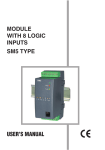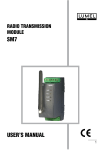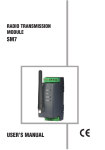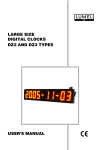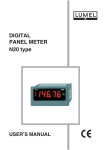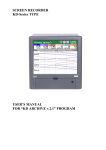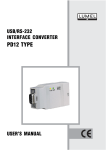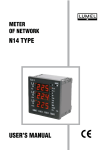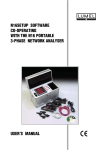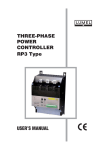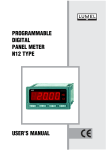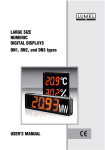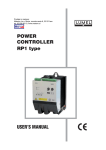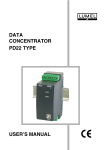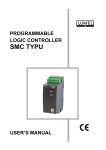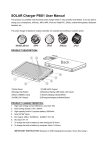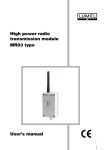Download USER`S MANUAL MODULE OF LOGIC OUTPUTS SM4 TYPE
Transcript
MODULE OF LOGIC OUTPUTS SM4 TYPE USER’S MANUAL Contents 1. APPLICATION................................................................................. 5 2. MODULE SET................................................................................. 6 3. BASIC REQUIREMENTS AND OPERATIONAL SAFETY............. 6 4. INSTALLATION .............................................................................. 8 4.1. Module fitting........................................................................... 8 4.2. Terminal description................................................................ 9 5. SERVICE....................................................................................... 12 5.1. Description of the MODBUS protocol implementation.......... 13 5.2. Description of the MODBUS protocol functions.................... 14 5.3. Map of module registers........................................................ 17 5.4. Set of module registers......................................................... 18 6. TECHNICAL DATA........................................................................ 23 7. BEFORE A DAMAGE WILL BE DECLARED............................... 25 8. ORDERING CODES...................................................................... 26 9. MAINTENANCE AND GUARANTEE............................................ 27 1. APPLICATION The SM4 module of logic outputs is destined to control simple actuators through assignment of logic states received from the master device through the RS-485 interface. The module can have 8 logic outputs or 4 relay outputs (depending on the execution) and RS-485 and RS-232 interfaces with MODBUS RTU and ASCII transmission protocols. RS-232 and RS-485 ports are galvanically isolated from output signals and the supply. The module programming is possible by means of the RS-485 or RS-232 port. A connecting wire to connect with the PC computer (RS-232) is included to the SM4 module set. Module parameters: 8 outputs of OC type or 4 relay outputs, RS-485 communication interface with MODBUS RTU and ASCII transmission protocols to work in industrial systems with an optical transmission signalling on LED diodes, Configurable baud rate: 2400....115200 bit/s Fig.1. View of SM4 module 2. MODULE SET The module set includes: SM4 module....................................................................................1 pc, User’s manual ................................................................................1 pc, Guarantee card...............................................................................1 pc, BU1005 plug with screw terminals..................................................2 pcs, BU0204 plug with screw terminals..................................................2 pcs, Hole plug of the RS-232 socket.......................................................1 pc, RS-232 cable for the PC computer connection (1,5 m) .................1 pc. 3. BASIC REQUIREMENTS AND OPERATIONAL SERVICE Symbols located in this service manual mean: WARNING! Warning of potential, hazardous situations. Especially important. One must acquaint with this before connecting the module. The non-observance of notices marked by these symbols can occasion severe injuries of the personnel and the damage of the instrument. CAUTION! Designates a general useful note. If you observe it, handling of the module is made easier. One must take note of this, when the instrument is working inconsistently to the expectations. Possible consequences if disregarded ! In the security scope the module meets the requirements of the EN 61010 -standard. Remarks concerning the operator safety: 1. General - The SM4 module is destined to be mounted on a 35 mm mounting rail. - Non-authorized removal of the required housing, inappropriate use, incorrect installation or operation creates the risk of injury to personnel or damage to equipment. For more detailed information please study the user’s manual. - All operations concerning transport, installation, and commissioning as well as maintenance must be carried out by qualified, skilled personnel and national regulations for the prevention of accidents must be observed. - According to this basic safety information, qualified, skilled personnel are persons who are familiar with the installation, assembly, commissioning, and operation of the product and who have qualifications necessary for their occupation. 2. Transport, storage Please observe the notes on transport, storage and appropriate handling. Observe the climatic conditions given in Technical Data. 3. Installation - The meter must be installed according to the regulation and instructions given in this user’s manual. - Ensure proper handling and avoid mechanical stress. - Do not bend any components and do not change any insulation distances. - Do not touch any electronic components and contacts. - Instruments may contain electrostatically sensitive components, which can easily be damaged by inappropriate handling. - Do not damage or destroy any electrical components since this might endanger your health! 4. Electrical connection - Before switching the instrument on, one must check the correctness of connection to the network. - In case of the protection terminal connection with a separate lead one must remember to connect it before the connection of the instrument to the mains. - When working on live instruments, the applicable national regulations for the prevention of accidents must be observed. - The electrical installation must be carried out according to the appropriate regulations (cable cross-sections, fuses, PE connection). Additional information can be obtained from the user’s guide. - The documentation contains information about installation in compliance withEMC (shielding, grounding, filters and cables). These notes must be observed for all CE-marked products. - The manufacturer of the measuring system or installed devices is responsible for the compliance with the required limit values demanded by the EMC legislation. 5. Operation - Measuring systems including SM4 modules, must be equipped with protection devices according to the corresponding standard and regulations for prevention of accidents. - After the instrument has been disconnected from the supply voltage, live components and power connections must not be touched immediately because capacitors can be charged. - The housing must be closed during operation. - The RS-232 socket serves only to connect the device (Fig. 5) working with the MODBUS protocol. When the module socket is not used place the hole plug. 6. Maintenance and servicing. - Please observe the manufacturer’s documentation. - Read all product-specific safety and application notes in this user’s manual. Before taking the meter housing out, one must turn the supply off. The removal of the instrument housing during the warranty contract period may cause its cancellation. 4. INSTALLATION 4.1. Module fitting The module is foreseen to be fixed on a 35 mm mounting rail (EN 60715) The module housing is made of a non-flammable plastics. Housing dimensions: 45 x 120 x 98 mm. Connect external wires up to 2.5 mm2 cross-section (from supply and interface side) and up to 1.5 mm2 (from output signals side). Fig.2. Overall and assembly dimensions 4.2. Terminal description The supply and external signals must be connected in accordance with the description from the fig. 3 and tables 1 and 2. Notice: One must pay particular attention to the correct connection of external signals (see tables 1 and 2). Three diodes are located on the frontal plate: green - signals the supply connection green (RxD) - signals the data reception by the module yellow (TxD) - signals the data transmission by the module An example of logic output connection of OC type is presented below Fig.3. Electrical connections of the SM4 binary output module. Fig. 4. Example of logic output connection of OC type. Description of SM4 logic output module - Version with 8 outputs of OC type. Terminal 1 2 3 4 5 6 7 8 9 10 11, 12 13...15 16 17 18 Terminal description GND line of logic outputs OUT1 line - output No 1 OUT2 line - output No 2 OUT3 line - output No 3 OUT4 line - output No 4 OUT5 line - output No 5 OUT6 line - output No 6 OUT7 line - output No 7 OUT8 line - output No 8 + line - output supply voltage Module supply lines Not used RS-485 interface mass with opto-isolation Line A of RS-485 interface with opto-isolation Line B of RS-485 interface with opto-isolation Description of SM4 logic output module - Version with 4 relay outputs. Terminal 10 1 2, 3 4, 5 6, 7 8, 9 10 11, 12 13...15 16 17 18 Table 1 Terminal description GND line Output relay No 1 Output relay No 2 Output relay No 3 Output relay No 4 5 V d.c. line Module supply lines Not used GND line of RS-485 interface with opto-isolation Line A of RS-485 interface with opto-isolation Line B of RS-485 interface with opto-isolation Table 2 11 Fig. 5. Connection way of RS-485 and RS-232 interfaces NOTICE: Taking in consideration electromagnetic interference one must use screened wires to connect binary outputs signals and RS-485 interface signals. One must connect the screen to the protective terminal in a single point. The supply must be connected by a two-wire cable with an appropriate cross-section and protected by a cut-out. The remove of the module housing during the guarantee period causes its cancellation. 5. SERVICE After connecting external signals and switching the supply on, the SM4 module is ready to work. The lighted green diode signals the module work. The green diode (RxD) signals the module polling, however the yellow diode (TxD) signals the module response. Diodes should ignite in cycles during the data transmission, both through the RS-232 and the RS-485 interface. The signal „+” (terminal 10), depending on the version, represents: - for SM4 with 8 outputs of OC type - The terminal to which one must apply the supply voltage for OC output circuits, the level of possible voltage: 5... 50 V d.c. - For SM4 with 4 relay outputs - the output 5 V with admissible load capacity 50 mA, one can use it to supply external circuits. 12 One can program all module parameters by means of RS-232 or RS-485. The RS-232 port has constant transmission parameters in accordance with technical data, what enables the connection with the module, even when programmed parameters of the RS-485 digital output are unknown (address, mode, rate). The RS-485 standard allows to the direct connection to 32 devices on a single serial link up to 1200 m. To connect a greater number of devices it is necessary to use additional intermediate-separating system e.g. converter/repeater of PD51 type).. The way of the interface connection in given in the user’s manual (fig.5 ). To obtain the correct transmission, it is necessary to connect A and B lines in parallel with their counterparts in other devices. The connection must be carried out with a shielded wire. The shield must be conneted to the protective terminal in a single point. The GND line serves to the additional protection of the interface line at long connections. One must connect it to the protective terminal (that is not necessary for the correct interface work). To obtain the connection with the PC computer through the RS-485 port, an RS-232/RS-485 converter (PD51) or an RS-485 interface card is indispensable. The marking of transmission lines for the card in the PC computer depends on the card manufacturer.To obtain the connection through the RS-232 port, the wire added to the module is sufficient. The connection way of both ports (RS-232 and RS-485) is shown on the fig. 5. The module can be connected to the device of master type only through one interface port. In case of a simultaneous connection of both ports, the module will work through the RS-232 interface. 5.1. Description of MODBUS protocol implementation The transmission protocol describes ways of the information exchange between devices through serial links. The MODBUS protocol has been implemented in the module in accordance with the PI-MBUS-300 Rev G specification of the Modicon company. Transducer Baud rate address Working modes Information unit Maximal response time 1... 247 2400, 4800, 9600, 19200, 38400, 57600, 115200 bit/s ASCII, RTU ASCII: 8N1, 7E1, 7O1 RTU: 8N2, 8E1, 8O1, 8N1 300 ms. The parameter configuration of the serial link is described in the further part of the User’s Manual. It consists on establishing the baud rate (baud parameter), device address (Adr parameter) and the information unit type (Mode parameter). 13 In case of the module connection with the computer through the RS-232 wire, the module set automatically following transmission parameters: Baud rate: 9600 bps Working mode: RTU 8N1 Address: 1 Notice: Each module connected to the communication network must: have a unique address, different from addresses of other devices connected to the network, identical baud rate and information unit type, the message sent with the address „0” is identified as the data transmission mode (transmission to many devices) 5.2. Description of the MODBUS protocol functions Following functions of the MODBUS protocol has been implemented in the SM4 module series. Table 3 Description of the MODBUS protocol functions Code 01 (01h) 03 (03h) 04 (04 h) 06 (06 h) 15 (0Fh) 16 (10h) 17 (11h) Meaning Readout of n-bit registers Readout of n-registers Readout of n-input registers Write of a single register Write of n-bit registers Write of n-registers Identification of slave device Readout of n-registers (code 01h) Function inaccessible in data transmission mode. Example: Readout of 10 registers beginning from the register with the 0898h (2200) address: Request: Device address Function 01 01 Register address Number of registers Hi Lo Hi Lo Checksum CRC 08 98 00 0A 3F 82 Answer: Device addres Function Number of bites Value from the register 2200 - 2207 Value from the register 2208 - 2209 Checksumm CRC 01 01 02 BDh 01h 096C 14 Readout of n-registers (code 03h) Function inaccessible in data transmission mode. Example: Readout of 2 registers beginning from the register with the 1DBDh (7613) address: Request: Device address Function 01 03 Register address Hi 1D Register address Lo BD Number of registers Hi 00 Number of registers Lo 02 Checksum CRC 52 43 Answer: Device address Function Number of bites 01 03 08 Value from the register 1DBD (7613) 3F 80 00 00 Value from the register 1DBE (7614) 40 00 00 00 Readout of n-input registers (code 04h) The function is inaccessible in the data transmission mode. Example: readout of 1 register with the 0FA3h (4003) address Request: Register address Hi 0F Device address Function 01 04 Device address Function Number of bytes 01 04 02 Register address Lo A3 Number of registers Hi 00 Number of registers Lo 01 Checksum CRC 42 8B Checksum CRC C2 FC Answer: Value from the register 0FA3 (4003) 00 Checksum CRC 01 78 F0 Write of values into the register (code 06h) The function is accessible in the data transmission mode. Example: Write of the register with 1DBDh (7613) address. Request: Device address Function 01 06 Register address Hi 1D Register address Lo BD Register address Hi 1D Register address Lo BD Value from the register 1DBD (7613) 3F 80 00 00 Checksum CRC 85 AD Answer: Device address Function 01 06 Value from the register 1DBD (7613) 3F 80 00 00 Checksum CRC 85 AD 15 Write into n-bit registers (code 0Fh) The function is accessible in the data transmission mode. Example: Write of 2 registers beginning from the register with 0898h (2200) address Request: Device address Function 01 0F Register address Number of registers Hi Lo Hi Lo 08 98 00 02 Number of bytes Value for the register 2200 - 2201 Checksum CRC 01 03 BE 02 Answer: Device address Function 01 0F Register address Number of registers Hi Lo Hi Lo 08 98 00 02 Checksum CRC 57 85 Write into n-registers (code 10h) The function is accessible in the data transmission mode. Example: Write 2 registers beginning from the register with 1DBDh (7613) address. Device address Function Request: 01 10 Register address Hi Lo 1D BD Number of registers Hi Lo 00 02 Number of bytes 08 Value from the register 1DBD (7613) Value from the register 1DBE (7614) 3F 80 00 00 40 00 00 00 Answer: Device address Function Register address Hi Register address Lo 01 10 1D BD Checksum CRC 03 09 Number of Number of Checksum registers registers (CRC) Lo Hi 00 02 D7 80 Report identifying the device (code 11h) Request: Device address Function 01 11 Checksum (CRC) C0 2C Answer: Device address Function Number of bytes Device identifier Device state Software version number Checksum 01 11 06 8C FF 3F 80 00 00 A6 F3 16 Device address - 01 Function - function No: 0x11; Number of bytes - 0x06 Device Identifier - 0x8C Device state - 0xFF Software version No - version implemented in the module: 1.00 XXXX - 4-byte variable of float type Checksum - 2 bytes in case of work in RTU mode - 1 byte in case of work in ASCII mode 5.3. Map of module registers Map of the SM4 series module registers Range of Value type addresses Table 4 Description 2200-2215 bool (1 bit) The value is located in 1-bit register. Registers can be read out and written. 4000-4100 int (16 bits) The value is located in 16-bit registers. The register content corresponds to the 32-bit register contents from the 7500 area. Registers are only for readout. 4200-4300 int (16 bits) The value is located in 16-bit registers. The register content corresponds to the 32-bit register contents from the 7600 area. Registers can be read out and written. 7500-7600 float (32 bits) The value is located in the 2-bit register. Registers are only for readout. 7600-7700 float (32 bits) The value is located in the 32-bit register. Registers can be read out and written. 17 5.4. Set of module registers The value is located in 32-bit registers. Write(w) / Readout ( r) Unit Table 5 The value is located in 16-bit registers. The register contents corresponds to the content of 32-bit registers from the area 7500. Set of registers for readout the SM4 module. 4000 7500 Identifer r - Constant identifying the device (8C) 4001 4002 7501 7502 Status 1 Status 2 r r - - Status 1 is a register describing current states of binary outputs. Status 2 is a register describing current transmission parameters. Name Quantity name OUT8 state OUT7 state OUT6 state OUT5 state OUT4 state OUT3 state OUT2 state OUT1 state Description of the status 1 register X X X X X X X X X X X bits 15 14 13 12 11 10 9 8 7 6 5 4 3 2 1 X X X X X MSB Bit-15...8 Not used State 0 Bit-7 OUT8 output state 0 - inactive (0) 1 - active (1) Bit-6 OUT7 output state 0 - inactive (0) 1 - active (1) 18 0 LSB Bit-5 OUT6 output state 0 - inactive (0) 1 - active (1) Bit-2 OUT3 output state 0 - inactive (0) 1 - active (1) Bit-4 OUT5 output state 0 - inactive (0) 1 - active (1) Bit-1 OUT2 output state 0 - inactive (0) 1 - active (1) Bit-3 OUT4 output state 0 - inactive (0) 1 - active (1) Bit-0 OUT1 output state 0 - inactive (0) 1 - active (1) Description of the Status2 register Operating mode and information unit X X X X X Baud rate X X X X X X X X X X 15 14 13 12 11 10 bits 9 8 7 6 5 4 3 2 1 MSB X 0 LSB Bit-15...6 Not used State 0 Bit-5...3 Working mode and information unit 000 - interface turned on 001 - 8N1 - ASCII 010 - 7E1 - ASCII 011 - 7O1 - ASCII 100 - 8N2 - RTU 101 - 8E1 - RTU 110 - 8O1 - RTU 111 - 8N1 - RTU Bit-1...0 Baud rate 000 - 2400 bit/s 001 - 4800 bit/s 010 - 9600 bit/s 011 - 19200 bit/s 100 - 38400 bit/s 101 - 57600 bit/s 110 - 115200 bit/s 19 Set of registers for readout and write the SM4 module - in the version with eight outputs of OC type. The value is located in 32 bit registers. Symbol 4200 7600 Identifier 4201 4202 7601 7602 Rate Mode Write (w)/Readout (r) The value is located in 16 bit registers. The register contents correspond to the contents of 32-bit registers from the area 7600 The value is located in 1 bit registers. The register contents correspond to the contents of 32-bit registers from the area 7600 Table 6 Range o 8C SM4 identifier 0... 6 Baud rate of RS-485 interface transmission (bit/s) w/r w/r Description 0 2400 1 4800 2 9600 3 19 200 4 5 6 38400 57600 115200 Transmission mode through RS-485 interface 0... 7 2200 20 0 1 2 3 4 5 6 7 Interface switched off ASCII 8N1 ASCII 7E1 ASCII 7O1 RTU 8N2 RTU 8E1 RTU 8O1 RTU 8N1 4203 7603 Address w/r 1... 247 Device address in the RS-485 interface network 4204 7604 Apply w/r 0... 1 Register confirming changes of transmission parameters 4205 7605 Output 1 w/r 0... 1 State of the output 1 2201 4206 7606 Output 2 w/r 0... 1 State of the output 2 2202 4207 7607 Output 3 w/r 0... 1 State of the output 3 2203 4208 7608 Output 4 w/r 0... 1 State of the output 4 2204 4209 7609 Output 5 w/r 0... 1 State of the output 5 2205 4210 7610 Output 6 w/r 0... 1 State of the output 6 2206 4211 7611 Output 7 w/r 0... 1 State of the output 7 2207 4212 7612 Output 8 w/r 0... 1 State of the output 8 4213 Output 1 7613 Safety state w/r 0... 1 Safety state of the output 1 2209 4214 Output 2 7614 Safety state w/r 0... 1 Safety state of the output 2 2210 4215 Output 3 7615 Safety state w/r 0... 1 Safety state of the output 3 2211 4216 Output 4 7616 Safety state w/r 0... 1 Safety state of the output 4 2212 4217 Output 5 7617 Safety state w/r 0... 1 Safety state of the output 5 2213 4218 Output 6 7618 Safety state w/r 0... 1 Safety state of the output 6 2214 4219 Output 7 7619 Safety state w/r 0... 1 Safety state of the output 7 2215 4220 Output 8 7620 Safety state w/r 0... 1 Safety state of the output 8 4221 7621 Admissible silent time on the bus w/r 0...65000 sec Setup time, after which, if there was not a transmission from SM4, the switching of outputs in a safe state follows. 2208 21 The value is located in 32 bit registers. Symbol 4200 7600 Identifier 4201 4202 7601 7602 Rate Mode Write (w)/Readout (r) The value is located in 16 bit registers. The register contents correspond to the contents of 32-bit registers from the area 7600 The value is located in 1 bit registers. The register contents correspond to the contents of 32-bit registers from the area 7600 Set of registers for readout and write the SM4 module in the version with four relay outputs. Table 7 Range r 8C SM4 identifier 0... 6 Baud rate of RS-485 interface transmission (bit/s) w/r w/r Description 0 2400 1 4800 2 9600 3 19 200 4 5 6 38400 57600 115200 Transmission mode through RS-485 interface 0... 7 2200 22 0 1 2 3 4 5 6 7 Interface switched off ASCII 8N1 ASCII 7E1 ASCII 7O1 RTU 8N2 RTU 8E1 RTU 8O1 RTU 8N1 Device address in the RS-485 interface network 4203 7603 Address w/r 1... 247 4204 7604 Apply w/r 0... 1 Register confirming changes of transmission parameters 4205 7605 Output 1 w/r 0... 1 State of the output 1 2201 4206 7606 Output 2 w/r 0... 1 State of the output 2 2202 4207 7607 Output 3 w/r 0... 1 State of the output 3 2203 4208 7608 Output 4 w/r 0... 1 State of the output 4 4209 7609 – – – Not used 4210 7610 – – – Not used 4211 7611 – – – Not used 4212 7612 – – – Not used 4213 Output 1 7613 Safety state w/r 0... 1 Set safety state of output 1 2209 4214 Output 2 7614 Safety state w/r 0... 1 Set safety state of output 2 2210 4215 Output 3 7615 Safety state w/r 0... 1 Set safety state of output 3 2211 4216 Output 4 7616 Safety state w/r 0... 1 Set safety state of output 4 4217 7617 – – – Not used 4218 7618 – – – Not used 4219 7619 – – – Not used 4220 7620 – – – Not used 4221 7621 Admissible silent time on the bus w/r 0...65000 sec Setup time, after which, if there was not a transmission from SM4, the switching of outputs in a safe state follows 2208 6. TECHNICAL DATA Transmission data: a) RS-485 interface: transmission protocol ASCII RTU baud rate address MODBUS 8N1, 7E1, 7O1 8N2, 8E1, 8O1, 8N1 2400, 4800, 9600, 19200, 38400 57600, 115200 bit/s 1...247 23 b) RS-232 interface: transmission protocol RTU baud rate address MODBUS 8N1 9600 1 Load capacity of outputs 0.1 A for max. 2 active outputs simultaneously 0.05 A for all active outputs simultaneously Load capacity of relay outputs (voltageless make contacts): - voltage - current - resistance load 250 V a.c., 150 V d.c. 5 A 30 V d.c., 250 V a.c. 1250 VA, 150 W Module power consumption 4 VA Rated operation conditions: - supply voltage 20...24...50 V a.c./d.c. or 85...230...253 V a.c./d.c. - supply voltage frequency 40...50/60...440 Hz - ambient temperature 0...23...55°C - relative humidity < 95% (inadmissible condensation) - external magnetic field < 400 A/m - working position any Storage and handling conditions: - ambient temperature - 20... 70°C - relative humidity < 95% (inadmissible condensation) Ensured protection grades: - from frontal housing side - from terminal side IP 40 IP 20 Overall dimensions 45 x 120 x 100 mm Weight < 0.25 kg Housing adapted to be assembled on a rail 24 Electromagnetic compatibility: - immunity EN 61000-6-2 - emission EN 61000-6-4 Safety requirements acc. to en EN 61010-1: - installation category III - pollution grade 2 Maximal phase-to-earth voltage: - for supply circuits - for other circuits 300 V 50 V 7. BEFORE A DAMAGE WILL BE DECLARED SYMPTOMS PROCEDURE 1. The module green diode does not light up. Check the connection of the network cable. 2. The module does not establish communication with the master device through the RS-232 port. Lack of communication transmission signalling on RxD and TxD diodes. Check if the cable is connected to the appropriate socket in the module. Check if the master device is set on the baud rate 9600, mode 8N1, address 1. 3. The module does not establish communication with the master device through the RS-485 port. Lack of communication transmission signalling on RxD and TxD diodes. Check if the cable is connected to the appropriate socket in the module. Check if the master device is set on the same transmission parameters as the module (baud rate, mode, address) In case of necessity to change transmission parameters when one cannot establish communication through RS-485, one must use the RS-232 port which has constant transmission parameters (in case of further problems see point 2). After changing RS-485 parameters into required, one can change over into the RS-885 port. NOTES (RS-232 has constant transmission parameters) 25 8. ORDERING CODES 8-channel module of logic outputs - SM4 X X XX X Supply voltage: 85...230...253 V a.c./d.c..................................................... 1 20...24...50 V a.c./d.c......................................................... 2 as ordered*........................................................................ X Kind of outputs: 8 outputs of OC type..................................................................1 4 relay outputs...........................................................................2 Version: standard...........................................................................................00 custom-made.................................................................................. XX Extra requirements; without an extra quality inspection certificate.......................................... 8 with an extra quality inspection certificate............................................... 7 in compliance with user’s agreement *.................................................... X * The manufacturer will establish the code numbering Ordering example: Code SM4 - 1. 2. 00 .1 means: SM4 - 8-channel module of binary outputs 1 - supply voltage: 85...230...253 V a.c/d.c, 2 - kind of outputs: with 4 relay outputs 00 - standard (catalogue) version 1 - with an extra quality inspection certificate 26 9. MAINTENANCE AND WARRANTY The SM4 module does not require any periodical maintenance. In case of some incorrect operations: 1. After the dispatch date and within the period stated in the warranty card One should return the instrument to the Manufacturer’s Quality Inspection Dept. If the instrument has been used in compliance with the instructions,the Manufacturer guaranties to repair it free of charge. The disassembling of the housing causes the cancellation of the granted warranty. 2. After the warranty period One should send the instrument to repair it in a authorized service workshop. Spare parts are available for the period of five years from the date of purchase. The Manufacturer reserves the right to make changes in design and specifications of any products as engineering advances or necessity requires. 27 Lubuskie Zak³ady Aparatów Elektrycznych - LUMEL S.A. ul. Sulechowska 1, 65-022 Zielona Góra, Poland Export Department: Tel.: (48-68) 329 53 02 or 53 04 Fax: (48-68) 325 40 91 e-mail: [email protected] 28 SM4-07.D Tel.: (48-68) 329 51 00 (exchange) Fax: (48-68) 329 51 01 www.lumel.com.pl e-mail: [email protected]




























